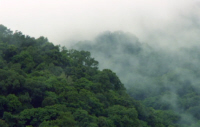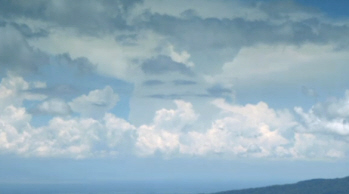Rainfall
The ability of water to exist in all 3 states, solid, liquid & gas
Almost all life on our planet depends on the energy we received from the sun. Our location close to the sun provides one critical benefit it allows the presence of liquid water. If our planet was much closer to the sun, it would be too hot and the water would boil away. Too far away, and it would freeze. Our planet is in what's known as the habitable zone this zone where water can exist and life can flourish. Earth may be dangerously close to the sun, but this is the price that has to be paid to sustain life. And our location close to the sun is even more favourable than it first appears. The Earth orbits the sun at just the right distance to allow water to exist in all three states as a solid, a liquid and a gas. And it's switching between those states all the time but water at each of these states behaves very differently, and it's those differences that generate the climate system as we know on Earth.

Cloud Forest, Calilegua
It's the middle of January. This time of year gives us a great opportunity to see two ways in which water changes state, with very different consequences.
We're in the southern hemisphere, in the foothills of the Andes in Argentina. This is the cloud forest of Calilegua, about 2000 m above sea level.
Here, you can see water moving between states and how this process transforms our planet. This is the cloud forest of Calilegua, we're 2000m above sea level. And, as you can see, clouds and definitely a feature here.
There is a wonderful thick wisp of cloud down in the valley there and then this great bank over the trees on the horizon. And then you've got these ghostly wisps climbing up above the trees.
It really is a magical place. This is a classic summer's day in the cloud forest. It's hot, it's humid. It's like being in a giant steam room. The humidity I'm feeling is because the heat has evaporated water, so the air is laden with vapour, the gaseous form of water. As the day progresses, some of this warm, moist air will change state again.
It's mid-afternoon and it's getting increasingly hot and steamy. The fact, it feels like this heat is about to trigger something absolutely spectacular. Throughout the day, the land has been absorbing more and more heat. In that heat warm up the moist air and forces it to rise high into the atmosphere. Forming towering cumulus clouds. These clouds and the transformation of water made visible.

Cumulus Cloud
The rising water vapour has cooled and changed state and become liquid again. What's incredible is watching this cumulus cloud growing in front of my very eyes. It has to be eight, 10 km tall already and you can almost feel the energy crackling away inside it. That's a tremendous sense of build-up and anticipation in the air.
Powerful updraughts push the cloud so high, the top spreads out to form a characteristic anvil shape. An approaching storm could last half an hour. It could last 10 or 12 hours. Sometimes they even join up with other storms to create destructive megastorms that can devastate the whole region.
These tropical storms are an extreme version of the familiar phenomenon. Rain. Rain is so familiar that it's easy to forget what a critical role it plays on Earth. It's the way in which water is transported from the oceans and deposited over land. Without the ability of water to change from liquid to gas, and back again, the land would be a dry and barren desert.
